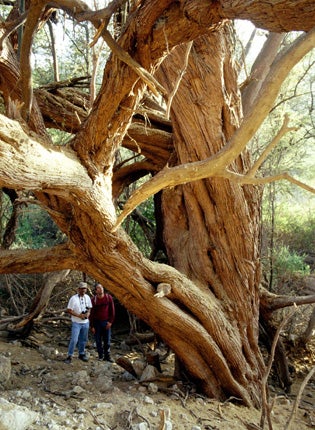Why the Nasca's big mistake was to cut down the huarango tree
Clearing key trees left pre-Inca culture exposed to floods and drought

Your support helps us to tell the story
From reproductive rights to climate change to Big Tech, The Independent is on the ground when the story is developing. Whether it's investigating the financials of Elon Musk's pro-Trump PAC or producing our latest documentary, 'The A Word', which shines a light on the American women fighting for reproductive rights, we know how important it is to parse out the facts from the messaging.
At such a critical moment in US history, we need reporters on the ground. Your donation allows us to keep sending journalists to speak to both sides of the story.
The Independent is trusted by Americans across the entire political spectrum. And unlike many other quality news outlets, we choose not to lock Americans out of our reporting and analysis with paywalls. We believe quality journalism should be available to everyone, paid for by those who can afford it.
Your support makes all the difference.At the height of their power, the Nasca had mastered the craft of weaving elaborate textiles and the art of painting fine, multicoloured pottery. They etched giant figures in the desert that only made sense if seen from the air, and they irrigated their crops with a network of underground aqueducts.
For more than eight centuries, the Nasca culture prospered in the coastal valleys of Peru until its sudden downfall around 600 AD, which many experts put down to the torrential rains and dramatic flooding brought on by one of the worst El Nino events in a millennium.
But a team of archaeologists has now found convincing evidence that this was only part of the story. The researchers believe the decline was self-inflicted and began with the cutting down of a tree that could have protected them from devastating climate change.
The Nasca, one of the most important of the pre-Inca civilisations of South America, are most famous for the "Nasca Lines", a series of elaborate geoglyphs etched into the desert covering huge areas, depicting animals, deities and geometric shapes.
After the Nasca Lines were discovered by the first passenger flights over the region, some pseudoscience authors suggested that since they could only be seen frome above, they must have been made with the help of space aliens. It is now accepted that the geoglyphs were created mundanely with long ropes tied to stakes in the ground, rather like present-day crop circles.
The Nasca survived in the semi-arid region by building irrigation canals to grow crops such as maize, squash, sweet potato and manioc. This reliable food supply enabled them to build a relatively sophisticated civilisation based on art and ritual, which nevertheless included the unpleasant practice of collecting severed heads as trophies.
All this came to an abrupt end, according to a new study, because the Nasca made the mistake of cutting down the huarango tree which would have protected them from the El Nino flooding and subsequent soil erosion and drought that turned the lush agricultural land into desert.
"The huarango is a remarkable nitrogen-fixing tree and it was an important source of food, forage, timber and fuel for the people," said David Beresford-Jones, an archaeologist and Nasca expert at the University of Cambridge. "It is the ecological keystone species in the desert zone, enhancing soil fertility and moisture, ameliorating desert extremes in the microclimate beneath its canopy and underpinning the floodplain with one of the deepest root systems of any tree known."
The researchers have excavated the lower Ica Valley of the Nasca domain and found clear evidence that vast swathes of huarango trees had been cut down to make way for crops. Dr Beresford-Jones believes that the Nasca eventually changed the landscape forever. "In time, gradual woodland clearance crossed an ecological threshold, which is sharply defined in such desert environments, exposing the landscape to the region's extraordinary desert winds and the effects of El Nino floods."
The huarango tree plays a "profound role" in preserving the sort of semi-arid environments where the Nasca lived, the scientists say in their study. "Successful agriculture is just not possible here without the protection afforded by trees. Indeed, these findings have undoubted contemporary resonance."
When the El Nino struck, the river cut into its floodplain, washed away the soil and destroyed the Nasca irrigation systems, making the farmland unworkable. The generations of Nasca that followed suffered higher infant mortalities and lower adult life expectancy.
Eventually, the Nasca capital of Cahuachi was abandoned and all that was left of the culture were archaeological artifacts.
Lost civilisations: Destroyed by nature
*Easter Island
It is thought that the native people felled the majority of the island's trees between 1200 AD and 1500 AD. The loss of palm trees upset the eco-system, driving away wildlife and drying up water supplies.
*Maya
Mayan civilisation stretched across the Yucatan Peninsula until 900 AD when cities were mysteriously abandoned. It is believed that the culture was wiped out by a series of droughts.
Join our commenting forum
Join thought-provoking conversations, follow other Independent readers and see their replies
Comments